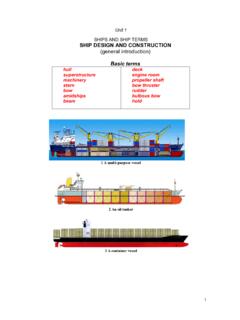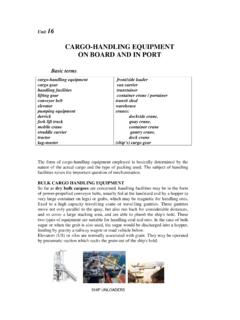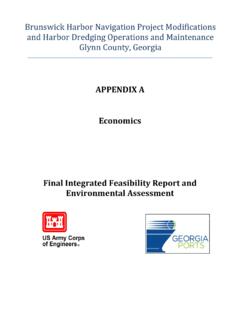Transcription of CARGO WORK: LOADING, DISCHARGING & STOWING CARGO
1 Unit 17 CARGO WORK: LOADING, DISCHARGING & STOWING CARGO Basic terms Introduction The aim of ship s officers and crewmembers on board should be to prevent damage or deterioration whilst the CARGO is under their care and to deliver it, as far as possible, in as good condition and order as it was when received aboard. If unacquainted with a certain type of CARGO you should ascertain as to its nature and any necessary precautions. Therefore, the Master and officers of all vessels require a good working knowledge of the various kinds of CARGO they are likely to carry: their peculiar characteristics, liability to damage, decay, or deterioration, their measurement, and the usual methods of packing, loading and DISCHARGING , stowage, dunnaging, etc.
2 , as the Master is responsible for the safe loading of his vessel and the proper stowage of the CARGO . The actual handling of the CARGO in loading and DISCHARGING is done by stevedores, who are experienced men appointed for this purpose when a vessel arrives at a port. This does not release the Master from the responsibility for the safety of the ship and CARGO , and he must supervise the work of the stevedores for general safety. Therefore, during stowage the first consideration must be given to safety, the CARGO must be stowed so that the ship will be stable and seaworthy, and it must be secured in such a manner that it cannot shift if the vessel encounters bad weather.
3 The type of vessel, the cubic capacity of her compartments destined for the CARGO and the appliances on board or on shore for loading or DISCHARGING , as well as the nature of the CARGO , affect the question of how to stow the CARGO in the best damage to CARGO deterioration liability to damage decay measurement methods of packing stowage dunnaging handling stevedores safety of the ship stable and seaworthy ship compartments shifting tainting sweating broaching of CARGO trim draught marks heel-list load lines possible manner.
4 The ship must be made neither stiff nor too tender. The next consideration is for the safety of the CARGO itself: it must not be damaged by shifting; certain commodities become easily tainted by others, water might find its way into the hold and condensation or sweating must be prevented. Valuable CARGO may be stolen or broached. Finally, the Chief Officer must bear in mind the various destinations of the goods the ship carries, and arrange things, as far as he can, to see that the CARGO for a certain place can be lifted out without disturbing the other CARGO .
5 The Chief Officer must watch closely the ship's stability ( what the ship's trim is or how she is sitting). Since a ship is supported by fluid pressure she will incline in any direction according to the position of the weights placed on her. The trim, therefore, is the angle that a ship is making, fore and aft, with the water. The levels are read by numbers painted on the ship's stem and stem. These are called draught marks. Another word is heel. This means a list or inclination from one side to another, caused by loading. The Chief Officer must watch the load lines.
6 They are welded or punched on and then painted. Loading, DISCHARGING , stowage, lashing, securing, etc. are the operations and activities specific for each type of ship and CARGO and these will be discussed in the following text (adapted from ). GENERAL CARGO Before containerisation, apart from bulk, most cargoes were handled as general cargoes. Even vehicles were handled as general CARGO before the advent of vehicle carriers and ro-ro vessels. Most ships had their own handling facilities in the form of derricks. Now the majority of CARGO is shipped in containers.
7 Thus there in no need for ships to have their own CARGO handling gear and they rely entirely on shore facilities . Much of the general CARGO carried now is of a type that cannot be readily packed into containers. General CARGO is loaded from the dock by traditional dockside cranes except where the weight precludes this. To speed up loading, much of the CARGO is unitised. The process of unitising consists of strapping together individual items of CARGO to form a single unit. Ships designed to carry heavy cargoes usually have their own CARGO handling gear in the form of heavy duty derricks or cranes.
8 Most CARGO vessels used to have tween decks (in between decks) in the holds but not many CARGO ships are fitted with these now. REFRIGERATED CARGO Apples, pears, kiwis, grapes and stonefruit (peaches, cherries etc.) are traditionally the main products that dominate this segment of reefer transportation. As many of us know from our own gardens, deciduous fruits (bjelogori an, listopadan) are highly seasonal. This makes the deciduous trade very different from the banana trade, which is a 12-month business. Optimum transit temperatures for deciduous fruit vary greatly per type and variety, but mostly range between 1 and +4 C.
9 The ability of the fruit to resist pressure is indicative of its ripeness and can be measured with a penetrometer. STOWING bananas in the hold The appropriate carriage temperature for bananas is limited by the susceptibility to chilling injury. Generally a carriage temperature of +13,3 C is to be maintained during the sea voyage. Bananas are a sort of perishable CARGO (pokvarljiv teret) and should arrive in a fresh, green unripe condition. If premature ripening takes place during the voyage, progressive ripening by emission of high amounts of ethylene can hardly be avoided.
10 Bananas may overripe to failure of the vessel's refrigeration system during the voyage. In comparison with the previously mentioned groups of CARGO , citrus fruit (ju no vo e, agrumi), oranges, lemons, grapefruit and mandarins, are a relatively simple CARGO to carry. A minor fluctuation in the hold temperature will not have disastrous effects. Successful shipments have even been carried out using ventilation alone, without refrigeration. Amongst the most familiar fungi (glivice) affecting citrus fruit are green and blue penicillium mould growth (shown to the right) which is accelerated by high storage temperatures.














